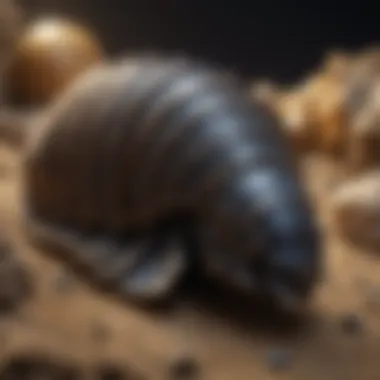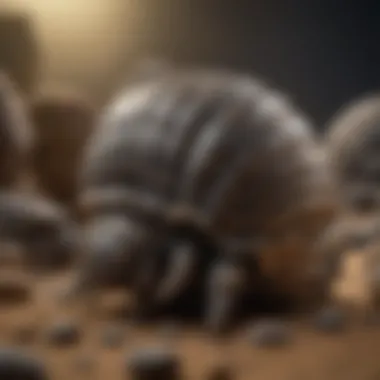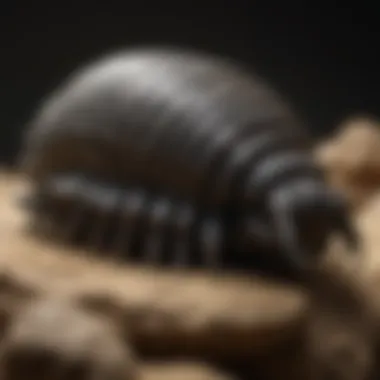Unveiling the Enigmatic World of Trilobites: A Detailed Guide for Enthusiasts


Rock and Fossil Identification
Trilobites are ancient arthropods that once roamed the Earth's oceans, leaving behind a fascinating trail of fossils for collectors to discover and admire. When identifying rocks and fossils that may contain trilobite specimens, it's essential to look for specific characteristics such as shape, texture, and color. Tools such as magnifying glasses, chisels, and brushes can aid in the intricate process of identification, allowing collectors to unearth these marvels of prehistoric life.
Collecting Tips and Techniques
To embark on a successful trilobite collecting expedition, enthusiasts must adhere to best practices ensuring both ethical and effective collecting techniques. Locating prime collecting sites, such as ancient sea beds or well-preserved sedimentary layers, can increase the likelihood of finding intact trilobite specimens. Practice caution and precision when extracting fossils, employing gentle tools and techniques to avoid damage and preserve the integrity of the specimen.
Preservation and Display
Once a trilobite specimen is carefully extracted from its rocky encasement, proper preservation is crucial to maintain its condition for years to come. Techniques such as cleaning with soft brushes, sealing in protective coatings, and storing in specialized containers or display cases can ensure the longevity of the fossil. Get creative with display ideas, showcasing trilobites in dynamic arrangements that highlight their unique characteristics and historical significance.
Geological Insights
Exploring the geological context of trilobite fossils opens up a world of insight into Earth's ancient history. Discover the significance of geological formations where trilobites are found, unraveling the mysteries of past environments and ecosystems. Historical insights into notable discoveries in trilobite research shed light on groundbreaking contributions to the field, offering a deeper appreciation for these iconic creatures of the distant past.
Introduction
Trilobites, ancient arthropods that once roamed the primordial seas, hold a mystique that captures the curiosity of collectors and paleontologists alike. In this comprehensive guide, we delve into the magnificent world of trilobites, unveiling their enigmatic past and shedding light on their enduring significance in the scientific community. From unraveling their evolutionary journey to offering expert advice on acquiring and preserving these fossil treasures, this article serves as a beacon for enthusiasts looking to deepen their understanding and appreciation of trilobites.
What are Trilobites?
Origin and Classification
The origin and classification of trilobites provide a vital foundation for comprehending these intriguing creatures. Tracing back to over 500 million years ago, trilobites belong to the extinct subphylum of arthropods, boasting a diverse array of species with unique characteristics. Their classification into various orders, families, and genera aids in categorizing and studying these ancient beings, offering insights into their evolutionary relationships and adaptations. Understanding the origin and classification of trilobites forms the bedrock for appreciating their diversity and evolutionary history in the context of this guide.
Physical Characteristics
The physical characteristics of trilobites serve as a testament to their evolution and survival strategies throughout different geological periods. With distinct body segments, a hardened exoskeleton, and intricate appendages, trilobites exhibit a remarkable array of forms and sizes. Their complex eyes, well-preserved in fossil records, depict the visual acuity of these ancient marine inhabitants. Exploring the physical attributes of trilobites not only fascinates collectors but also provides valuable insights into their ecology, behavior, and adaptations to prehistoric environments.
Significance of Trilobites
Role in Paleontology
Trilobites play a pivotal role in paleontology, acting as index fossils for dating geological strata and reconstructing ancient ecosystems. Their abundance in the fossil record and distinct morphological features enable scientists to make biostratigraphic correlations across different locations globally. By studying trilobites, researchers unlock clues about past climates, evolutionary patterns, and biotic interactions, shaping our understanding of Earth's history and biodiversity.
Evolutionary Insights


The evolutionary insights garnered from trilobites offer a window into the profound changes that shaped life on Earth. Through comparative anatomy, phylogenetic analyses, and fossil evidence, scientists unravel the evolutionary relationships among trilobite species and their connections to modern arthropods. Trilobites exemplify adaptation and diversification over vast geological timescales, showcasing the mechanisms by which life forms respond to environmental challenges and opportunities.
Appeal to Collectors
Aesthetic Value
Trilobites hold an intrinsic aesthetic value that captivates collectors and enthusiasts worldwide. Their intricate exoskeletons, diverse morphologies, and fossilized preservation present a mesmerizing display of natural artistry. Collectors appreciate trilobites not only for their scientific significance but also for their visual allure and decorative appeal, making them prized possessions in private collections and academic institutions.
Scientific Interest
Beyond their visual charm, trilobites ignite scientific curiosity and exploration due to their rich fossil record and evolutionary significance. By examining trilobite fossils, researchers gain critical insights into ancient marine ecosystems, paleoenvironments, and biological adaptations. The study of trilobites contributes to paleontological research, evolutionary studies, and environmental reconstruction, positioning these arthropods as cornerstones in understanding Earth's biological history.
Trilobite Acquisition
Trilobite acquisition plays a crucial role in this comprehensive guide, offering collectors the foundational knowledge needed to start or enhance their collections. By delving into the realm of trilobites, enthusiasts can gain valuable insights into the history and significance of these ancient arthropods. Understanding where to find trilobites and how to acquire them ethically and authentically are key aspects that this section will explore in detail. Trilobite acquisition sets the stage for collectors to engage with these fascinating creatures on a deeper level, making it a pivotal topic in this article.
Where to Find Trilobites
Popular Geological Sites
Popular geological sites serve as treasure troves for trilobite enthusiasts, offering a rich array of specimens waiting to be discovered. These sites, whether coastal cliffs, quarries, or specific geological formations, hold insights into the ancient world and the fossils it preserves. Their accessibility and abundant fossil deposits make them prime locations for collectors looking to expand their trilobite collections. The unique geological conditions of these sites provide a conducive environment for fossil preservation, ensuring a high likelihood of finding well-preserved trilobite specimens.
Tips for Field Collection
Field collection tips are indispensable for collectors venturing out to discover trilobites in their natural habitat. These tips range from proper tools and techniques to ethical considerations when collecting fossils. Understanding the geological context, weathering patterns, and sedimentary layers can significantly enhance one's success in finding trilobites. Furthermore, learning how to respect and preserve the environment during field collection is essential to ensure the sustainable enjoyment of fossil hunting. By incorporating these tips, collectors can optimize their field collection experiences and build their trilobite collections thoughtfully.
Purchasing Trilobites
Acquiring trilobites through purchases is another avenue for collectors to expand their collections and acquire specimens they may not find in the field. This section delves into the considerations and nuances of purchasing trilobites, covering authenticity and ethical sourcing practices to guide collectors in making informed and responsible buying decisions.
Authenticity Considerations
Authenticity considerations are paramount when purchasing trilobites, ensuring that collectors receive genuine specimens free from alterations or fabrications. Understanding how to assess the authenticity of trilobite fossils through visual cues and provenance information is crucial in a market where fraud can occur. By highlighting the key characteristics of authentic trilobite specimens, collectors can navigate the market with confidence and discernment, building collections with genuine and scientifically valuable fossils.
Ethical Sourcing
Ethical sourcing practices emphasize the importance of obtaining trilobite specimens through legal and sustainable means, respecting regulations and conservation efforts. Collectors need to be aware of the ethical implications of their purchases, especially concerning endangered species or fossils extracted through destructive methods. By supporting ethical sourcing initiatives and responsible dealers, collectors can contribute to the preservation of trilobites and their habitats, ensuring the long-term availability of these treasures for future enthusiasts.


Trilobite Preservation
Trilobite preservation is a critical aspect of our guide on the captivating world of trilobites. Understanding how to properly clean and store these ancient arthropods ensures their longevity and allows collectors to showcase them effectively. Preserving trilobites not only maintains their aesthetic appeal but also safeguards their scientific value for future study. By exploring the best practices and materials to avoid in trilobite preservation, collectors can elevate their experience and maintain the integrity of their collection.
Cleaning and Storage
Best Practices
In the realm of trilobite preservation, adhering to best practices is paramount. These practices involve using gentle cleaning methods to remove debris without damaging the delicate exoskeleton of the trilobite. Brushing off sediment with soft bristles and utilizing mild cleaning solutions can help restore the specimen's natural shine without causing harm. By employing best practices, collectors can ensure the preservation of intricate details on the trilobite's exoskeleton, enhancing its visual appeal and scientific significance.
Materials to Avoid
Certain materials pose risks to trilobite preservation efforts and should be avoided to prevent damage. Abrasive tools such as wire brushes or harsh chemicals can erode the exoskeleton and degrade the specimen over time. Acids and strong cleaning solutions may alter the trilobite's appearance and compromise its authenticity. By steering clear of these detrimental materials, collectors can safeguard their trilobite specimens and maintain their condition for years to come.
Display Techniques
Mounting Options
When considering how to display trilobites, selecting the right mounting option is crucial. Mounting platforms should provide stability and security for the specimen while enhancing its visual impact. Utilizing clear stands or mounting racks that allow for a 360-degree view of the trilobite can showcase its intricate features from all angles. By choosing appropriate mounting options, collectors can create striking displays that highlight the beauty and uniqueness of each trilobite in their collection.
Lighting Considerations
Lighting plays a pivotal role in accentuating the details of trilobite specimens on display. Soft, ambient lighting can illuminate the specimen without causing glare or shadows that may obscure its features. Positioning adjustable lighting sources to highlight specific areas of the trilobite, such as its crystalline eyes or segmented exoskeleton, can draw attention to its intricate structures. By paying attention to lighting considerations, collectors can create visually appealing displays that showcase the mesmerizing allure of trilobites.
Trilobites for Sale
In this section of the article, we delve into the crucial topic of Trilobites for Sale, which holds significant importance for both seasoned collectors and novice enthusiasts. Understanding where and how to acquire these ancient arthropods is essential for anyone passionate about adding them to their collection. Exploring the world of Trilobites for Sale not only allows collectors to expand their knowledge but also contributes to the preservation and study of these fascinating creatures.
As collectors venture into the realm of Trilobites for Sale, they encounter a plethora of options, from online marketplaces to specialty dealers. Making informed choices while considering authenticity, ethical sourcing, and overall quality is paramount in enhancing one's collection. By delving into this aspect of the trilobite world, collectors can further appreciate the nuances of acquiring these specimens.
Online Marketplaces
Top Platforms
Top Platforms play a pivotal role in the realm of Trilobites for Sale, offering collectors a convenient and diverse array of options to explore. These platforms act as virtual hubs where sellers showcase their trilobite specimens, catering to a global audience of collectors. The key characteristic of Top Platforms lies in their ability to provide a wide selection of trilobites, ranging from common species to rare finds, thus appealing to a broad spectrum of collectors.
The unique feature of Top Platforms is the opportunity for collectors to interact directly with sellers, inquire about specific specimens, and engage in bidding or purchasing processes. This direct engagement fosters a sense of community among collectors and facilitates the exchange of knowledge and experiences. However, collectors must exercise caution regarding the authenticity and provenance of specimens when utilizing Top Platforms for acquiring trilobites.


Tips for Safe Transactions
Ensuring safe transactions is paramount when engaging in the world of Trilobites for Sale. Tips for Safe Transactions offer valuable insights into navigating the online marketplace landscape, safeguarding collectors from potential fraudulent activities and subpar acquisitions. The key characteristic of these tips lies in providing guidelines on verifying seller credibility, scrutinizing specimen images, and understanding return policies.
One unique feature of Tips for Safe Transactions is the emphasis on building trust and establishing clear communication channels with sellers. By following these tips, collectors can navigate the nuances of online transactions with confidence and mitigate risks associated with purchasing trilobites online. However, it is essential for collectors to remain vigilant and informed throughout the transaction process to ensure a secure and satisfying acquisition experience.
Considerations When Buying
Quality Assessment
Quality Assessment plays a pivotal role in the acquisition of trilobite specimens, guiding collectors in evaluating the condition, authenticity, and overall value of each specimen. Conducting a thorough quality assessment allows collectors to discern between well-preserved specimens and those that may lack historical significance or scientific value. The key characteristic of quality assessment lies in its holistic approach, considering factors such as specimen integrity, rarity, and preparation quality.
A unique feature of Quality Assessment is its emphasis on preserving the integrity of the trilobite specimen while appraising its worth. By employing quality assessment techniques, collectors can make informed decisions regarding the acquisition of trilobites, ensuring that each addition to their collection meets their desired standards. However, conducting a comprehensive quality assessment requires careful consideration and expertise to accurately assess the value and authenticity of trilobite specimens.
Price Factors
Price Factors serve as a vital aspect of the trilobite market, influencing collectors' purchasing decisions and overall investment in their collections. Understanding the key price factors allows collectors to navigate the market effectively, avoiding overpriced specimens or underestimating the value of rare finds. The key characteristic of price factors lies in their ability to reflect the rarity, quality, and demand for trilobite specimens.
One unique feature of Price Factors is their dynamic nature, fluctuating based on market trends, specimen rarity, and overall collector demand. By considering price factors when buying trilobites, collectors can make informed decisions regarding their acquisitions and ensure that they are obtaining specimens at competitive prices. However, staying informed about changing price trends and market influences is essential for collectors looking to make strategic purchases and expand their trilobite collection.
Conclusion
In this final segment of the comprehensive guide on exploring the fascinating world of trilobites, we bring together the essence of our exploration and understanding of these ancient arthropods. The importance of this conclusion lies in summarizing the key takeaways and insights gained throughout this guide for collectors and enthusiasts alike. By reflecting on the evolutionary significance, the allure to collectors, and the methods of acquisition and preservation discussed earlier, we reinforce the value of trilobites in the realm of paleontology and collecting.
It is crucial to note that trilobites not only offer a glimpse into prehistoric times but also serve as valuable scientific tools for understanding the Earth's history and evolution. The beauty of trilobites is not just in their aesthetic appeal but also in the depth of knowledge they provide about the ancient seas they once inhabited. Collectors play a vital role in preserving these specimens for future generations to appreciate and study, making trilobites a timeless fascination that bridges the gap between past and present.
The conclusion of this guide emphasizes the enduring charm and scientific importance of trilobites, encouraging collectors to continue their exploration and preservation efforts to uphold the legacy of these remarkable creatures.
Final Thoughts on Trilobites
Timeless Beauty
Delving into the aspect of 'Timeless Beauty' in the world of trilobites unveils a captivating allure that transcends time and trends. The inherent beauty of these ancient arthropods lies in their intricate exoskeletons, which serve as a testament to the artistry of evolution. Each fossilized trilobite boasts unique patterns and structures that captivate collectors and researchers alike, making them sought-after specimens in the world of paleontology.
The key characteristic of 'Timeless Beauty' in trilobites is its ability to evoke a sense of wonder and awe, transporting enthusiasts to primordial seas teeming with life. This aspect contributes significantly to the overall appeal of trilobites, making them a prized addition to collections and a subject of study for scientists seeking to unlock the mysteries of the past.
One of the primary advantages of 'Timeless Beauty' in trilobites is its enduring relevance and universal acclaim among collectors across the globe. The intricate details preserved in these ancient fossils provide a visual feast for the eyes and a wealth of information for researchers studying the evolution of life on Earth. While the rarity of well-preserved specimens may pose challenges for collectors, the unparalleled beauty of trilobites makes them a captivating choice for enthusiasts seeking to delve into the prehistoric wonders of our planet.
Continued Fascination
The concept of 'Continued Fascination' encapsulates the enduring allure of trilobites and their ability to sustain interest and curiosity over generations. Despite millennia passing since their extinction, trilobites continue to fascinate collectors, scientists, and enthusiasts alike with their rich history and diversity. The key characteristic of 'Continued Fascination' lies in the ever-evolving field of trilobite research, where new discoveries and insights shed light on these enigmatic creatures.
The enduring appeal of trilobites stems from their unparalleled diversity and unique adaptations to prehistoric environments, making them a subject of continual interest and study. As collectors uncover rare specimens and researchers unveil new findings about trilobite behavior and ecology, the fascination with these ancient arthropods only intensifies, further fueling the passion for understanding and preserving these remarkable creatures.
One of the main advantages of 'Continued Fascination' in trilobites is the endless opportunities for exploration and discovery they present to collectors and researchers. With new technologies and methodologies enhancing our understanding of trilobite biology and evolution, the ongoing fascination with these ancient creatures ensures that their legacy remains vibrant and enduring in the scientific community and the hearts of enthusiasts worldwide.







